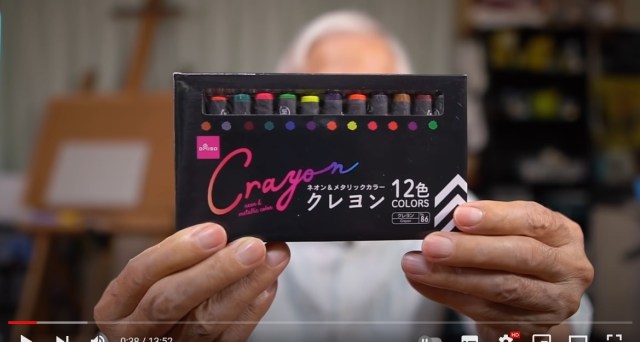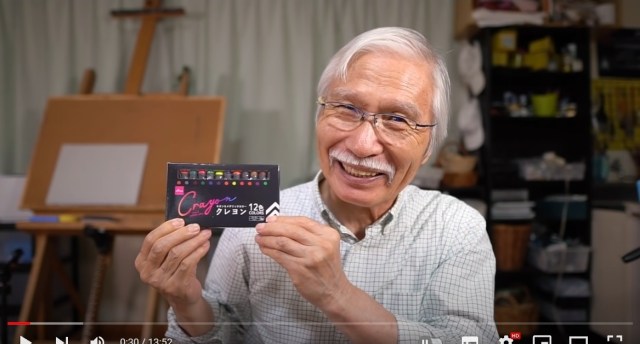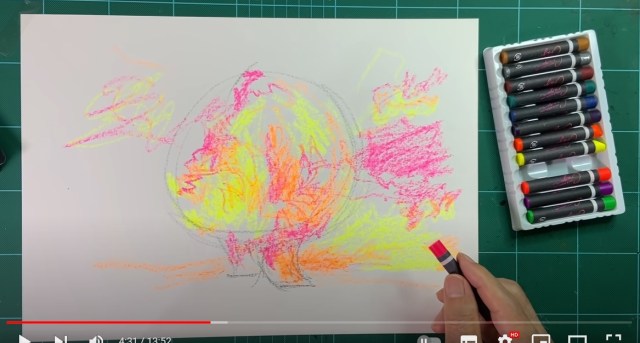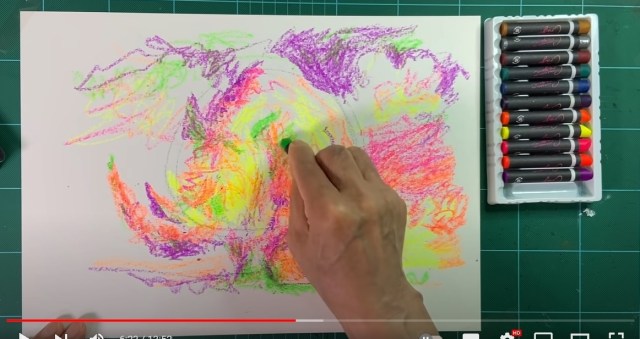
“Let’s overcome these barriers” says Shibasaki, who just might be everyone’s kind and cool Japanese art uncle.
They say it’s a poor craftsman who blames his tools, but what if you’re a poor artist in the sense that you simply don’t have a lot of money to spend on art supplies? You might find yourself searching for the least expensive pigments you can find, and that search might lead you to Daiso, Japan’s largest 100 yen store chain.
Daiso, as we’re all aware by now, sells everything, and sure enough, you can find crayons there. What’s more, they offer a pretty fancy-looking box of 12 metallic and fluorescent colors, all for their standard price of just 100 yen (US$0.92). But while Daiso selling crayons was a forgone conclusion, the real question is whether you can make beautiful art with them, and here with an answer is Harumichi Shibasaki.
Shibasaki may not be someone you’re familiar with, but his YouTube channel, Watercolor by Shibasaki, will instantly make you feel welcome. A veteran art instructor with a career spanning more than 40 years, Shibasaki has a warm, soft-spoken personality, and watching his videos you might find yourself wondering if the artist is actually a kind-hearted, laid-back Japanese uncle you never knew you had.
In the video below (which has English subtitles that can be turned on in the settings), Shibasaki sets out to create a picture using the Daiso crayons. He doesn’t say what he’s going to draw, asking you to see if you can guess before it’s finished, but at the very start he drops the hints that it’s a large animal native to Africa.
Shibasaki recognizes that using metallic and neon colors to paint wildlife is an unusual choice, and the way he goes about the process is surprising too. After a few quick body outlines, he starts working his way through the fluorescent colors one by one, adding wide patches of hue to test their appearance and the crayons’ feel. None of this is going to be cut out or wasted though; it’s all going to be part of the final picture.
He quickly finds out that there are some compromises that come with such budget-friendly supplies. The crayons leave behind a lot of powdery particles that need to be periodically swept off the paper, and in some cases don’t lay down as much color as he’d expect for a stroke, although the problems can be alleviated by pressing down more forcefully when drawing. Shibasaki’s strongest praise for the fluorescents are for the yellow and green crayons, with the latter, he says, really helping to bring out more of the lackluster red crayon’s color through the contrast it creates.
The metallic crayons don’t fare as well, though. Shibasaki’s intent was to use them for drawing the animal’s body, but they aren’t leaving quite enough color on the paper to add the details he wants, leading him to wonder if they lack a sufficient amount of base pigment. So to finish off the piece, Shibasaki switches over to some pricier Pentel crayons, whose fluorescents also make for smoother layering than the Daiso ones.
In the end, Shibasaki’s African animal comes out incredibly well, and his decision to combine fluorescent colors and wildlife has a soothing retro vibe, like something you might see hanging on a cafe wall in 1987.
As for his thoughts on the Daiso crayons? He’s got mixed feelings, saying “The fluorescent colors are pretty good! But the metallic effect I was expecting didn’t show at all. The fluorescent effects are lots of fun and great.” That doesn’t mean he regrets using them, though, and during the video he muses “But I feel more driven when facing such difficulties. Let’s overcome these barriers.”
So they may not be professional-grade, but if you’re of the mind that art is supposed to be fun, you should be able to get some artistic fun out of Daiso’s crayons (just remember that having fun with Daiso’s Light Up Poop Stick is still prohibited).
Related: Watercolor by Shibasaki YouTube channel
Source: YouTube/Watercolor by Shibasaki via Hachima Kiko
Images: YouTube/Watercolor by Shibasaki
● Want to hear about SoraNews24’s latest articles as soon as they’re published? Follow us on Facebook and Twitter!




 A visit to the largest Daiso 100 yen shop in all Japan【Photos】
A visit to the largest Daiso 100 yen shop in all Japan【Photos】 Often-overlooked castle in Japan looks so beautiful in the snow that we can’t take our eyes off it
Often-overlooked castle in Japan looks so beautiful in the snow that we can’t take our eyes off it Government study finds seniors active online more likely to feel life is worth living
Government study finds seniors active online more likely to feel life is worth living Daiso will help you warp your reflection with a psychedelic infinity mirror for under five bucks!
Daiso will help you warp your reflection with a psychedelic infinity mirror for under five bucks! Seiji cosplays as the hot new mascot Myaku-Myaku using only 100-yen products
Seiji cosplays as the hot new mascot Myaku-Myaku using only 100-yen products Japanese city loses residents’ personal data, which was on paper being transported on a windy day
Japanese city loses residents’ personal data, which was on paper being transported on a windy day Foreigner’s request for help in Tokyo makes us sad for the state of society
Foreigner’s request for help in Tokyo makes us sad for the state of society Should you add tartar sauce to Japanese curry rice? CoCo Ichi makes diners an unusual offer
Should you add tartar sauce to Japanese curry rice? CoCo Ichi makes diners an unusual offer Ghibli Park now selling “Grilled Frogs” from food cart in Valley of Witches
Ghibli Park now selling “Grilled Frogs” from food cart in Valley of Witches Seaside scenery, history, and so many desserts on Yokohama’s Akai Kutsu【Japan Loop Buses】
Seaside scenery, history, and so many desserts on Yokohama’s Akai Kutsu【Japan Loop Buses】 Historical figures get manga makeovers from artists of Spy x Family, My Hero Academia and more
Historical figures get manga makeovers from artists of Spy x Family, My Hero Academia and more Mt. Koya planning to instate visitor’s tax to cope with huge tourist numbers
Mt. Koya planning to instate visitor’s tax to cope with huge tourist numbers Beautiful Ghibli sealing wax kits let you create accessories and elegant letter decorations【Pics】
Beautiful Ghibli sealing wax kits let you create accessories and elegant letter decorations【Pics】 Suntory x Super Mario collaboration creates a clever way to transform into Mario【Videos】
Suntory x Super Mario collaboration creates a clever way to transform into Mario【Videos】 Shinjuku izakaya’s all-you-can-eat-and-drink plan is one of Tokyo’s best secret cheap eats
Shinjuku izakaya’s all-you-can-eat-and-drink plan is one of Tokyo’s best secret cheap eats McDonald’s new Happy Meals offer up cute and practical Sanrio lifestyle goods
McDonald’s new Happy Meals offer up cute and practical Sanrio lifestyle goods Japanese ramen restaurants under pressure from new yen banknotes
Japanese ramen restaurants under pressure from new yen banknotes French Fries Bread in Tokyo’s Shibuya becomes a hit on social media
French Fries Bread in Tokyo’s Shibuya becomes a hit on social media Studio Ghibli releases new action figures featuring Nausicaä of the Valley of the Wind characters
Studio Ghibli releases new action figures featuring Nausicaä of the Valley of the Wind characters New private rooms on Tokaido Shinkansen change the way we travel from Tokyo to Kyoto
New private rooms on Tokaido Shinkansen change the way we travel from Tokyo to Kyoto Red light district sushi restaurant in Tokyo shows us just how wrong we were about it
Red light district sushi restaurant in Tokyo shows us just how wrong we were about it Tokyo Tsukiji fish market site to be redeveloped with 50,000-seat stadium, hotel, shopping center
Tokyo Tsukiji fish market site to be redeveloped with 50,000-seat stadium, hotel, shopping center All-you-can-drink Starbucks and amazing views part of Tokyo’s new 170 meter-high sky lounge
All-you-can-drink Starbucks and amazing views part of Tokyo’s new 170 meter-high sky lounge Studio Ghibli releases Kiki’s Delivery Service chocolate cake pouches in Japan
Studio Ghibli releases Kiki’s Delivery Service chocolate cake pouches in Japan New definition of “Japanese whiskey” goes into effect to prevent fakes from fooling overseas buyers
New definition of “Japanese whiskey” goes into effect to prevent fakes from fooling overseas buyers Our Japanese reporter visits Costco in the U.S., finds super American and very Japanese things
Our Japanese reporter visits Costco in the U.S., finds super American and very Japanese things Studio Ghibli unveils Mother’s Day gift set that captures the love in My Neighbour Totoro
Studio Ghibli unveils Mother’s Day gift set that captures the love in My Neighbour Totoro More foreign tourists than ever before in history visited Japan last month
More foreign tourists than ever before in history visited Japan last month New Pokémon cakes let you eat your way through Pikachu and all the Eevee evolutions
New Pokémon cakes let you eat your way through Pikachu and all the Eevee evolutions Sales of Japan’s most convenient train ticket/shopping payment cards suspended indefinitely
Sales of Japan’s most convenient train ticket/shopping payment cards suspended indefinitely Sold-out Studio Ghibli desktop humidifiers are back so Totoro can help you through the dry season
Sold-out Studio Ghibli desktop humidifiers are back so Totoro can help you through the dry season Japanese government to make first change to romanization spelling rules since the 1950s
Japanese government to make first change to romanization spelling rules since the 1950s Ghibli founders Toshio Suzuki and Hayao Miyazaki contribute to Japanese whisky Totoro label design
Ghibli founders Toshio Suzuki and Hayao Miyazaki contribute to Japanese whisky Totoro label design Doraemon found buried at sea as scene from 1993 anime becomes real life【Photos】
Doraemon found buried at sea as scene from 1993 anime becomes real life【Photos】 Tokyo’s most famous Starbucks is closed
Tokyo’s most famous Starbucks is closed One Piece characters’ nationalities revealed, but fans have mixed opinions
One Piece characters’ nationalities revealed, but fans have mixed opinions We asked a Uniqlo employee what four things we should buy and their suggestions didn’t disappoint
We asked a Uniqlo employee what four things we should buy and their suggestions didn’t disappoint Princesses, fruits, and blacksmiths: Study reveals the 30 most unusual family names in Japan
Princesses, fruits, and blacksmiths: Study reveals the 30 most unusual family names in Japan We test Daiso’s new storage container to see if it keeps rice fluffy even after freezing
We test Daiso’s new storage container to see if it keeps rice fluffy even after freezing 100 yen store chain Daiso opens online shop with 30,000 items to choose from!
100 yen store chain Daiso opens online shop with 30,000 items to choose from! Daiso sells “emergency shelters,” and they have an amazing visual trick【Photos】
Daiso sells “emergency shelters,” and they have an amazing visual trick【Photos】 How to make an awesome Japanese summer dessert using only things you can buy at Daiso【SoraKitchen】
How to make an awesome Japanese summer dessert using only things you can buy at Daiso【SoraKitchen】 Is Daiso’s 500-yen grilling plate good enough for at-home yakiniku dinners? We find out!
Is Daiso’s 500-yen grilling plate good enough for at-home yakiniku dinners? We find out! What to buy at Daiso’s new Standard Products store in Tokyo
What to buy at Daiso’s new Standard Products store in Tokyo Our reporter buys a tiny kiddie pool from Daiso, has entirely too much fun with it
Our reporter buys a tiny kiddie pool from Daiso, has entirely too much fun with it Head of Japan’s most successful 100-yen chain calls himself “hopeless,” might need a hug
Head of Japan’s most successful 100-yen chain calls himself “hopeless,” might need a hug Ghibli, Star Wars, Breaking Bad: artist carves crayons into amazing characters
Ghibli, Star Wars, Breaking Bad: artist carves crayons into amazing characters Daiso releases shoulder bag series for every prefecture in Japan with surprising trivia facts
Daiso releases shoulder bag series for every prefecture in Japan with surprising trivia facts What’s the best spoon for Japanese curry?【Photos】
What’s the best spoon for Japanese curry?【Photos】 3 things to consider before buying Daiso’s Light Up Poop Stick
3 things to consider before buying Daiso’s Light Up Poop Stick Daiso’s Standard Products store — what’s worth buying and what’s not? Our expert weighs in
Daiso’s Standard Products store — what’s worth buying and what’s not? Our expert weighs in We try out a 100-yen store bowl designed for microwaving frozen udon noodles
We try out a 100-yen store bowl designed for microwaving frozen udon noodles Crazy cheap cosplay at Daiso? How to transform into Dragon Ball’s Vegeta at the discount shop
Crazy cheap cosplay at Daiso? How to transform into Dragon Ball’s Vegeta at the discount shop We test the cleaning power of the miniature washing machine from 100 yen shop Daiso
We test the cleaning power of the miniature washing machine from 100 yen shop Daiso
Leave a Reply